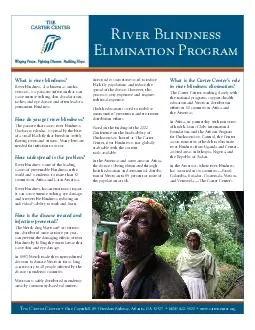/


How do you get river blindness The parasite that causes river blindness Onchocera volvulus is spread by the bites of a small black fly that breeds in swiftly flowing rivers and streams Many bites are needed for infection to occur How widespread is ID: 38966
Download Pdf The PPT/PDF document "River Blindness Elimination Program What..." is the property of its rightful owner. Permission is granted to download and print the materials on this web site for personal, non-commercial use only, and to display it on your personal computer provided you do not modify the materials and that you retain all copyright notices contained in the materials. By downloading content from our website, you accept the terms of this agreement.
River Blindness Elimination Program What is river blindness? River blindness, also known as oncho - cerciasis, is a parasitic infection that can cause intense itching, skin discoloration, rashes, and eye disease and often leads to permanent blindness. How do you get river blindness? The parasite that causes river blindness, Onchocera volvulus , is spread by the bites of a small black fly that breeds in swiftly flowing rivers and streams. Many bites are needed for infection to occur. How widespread is the problem? River blindness is one of the leading causes of preventable blindness in the world and is endemic to more than 30 countries in Africa and Latin America. River blindness has an enormous impact. It can cause intense itching, eye damage, and irreversible blindness, reducing an individual’s ability to work and learn. How is the disease treated and infection prevented? The Merck drug Mectizan ® or ivermec - tin, distributed once or more per year, can prevent the damaging effects of river blindness by killing the worm larvae that cause skin and eye damage. In 1987, Merck made the unpreceden decision to donate Mectizan for as long as necessary to all people affected by the disease in endemic countries. Mectizan is safely distributed in endemic areas by community-based volunteers. Insecticide is sometimes used to reduce black fly populations and reduce the spread of the disease. However, this process is very expensive and requires technical expertise. Health education is used to mobilize communities’ prevention and treatment distribution efforts. Based on the findings of the 2002 Conference on the Eradicability of Onchocerciasis hosted at The Carter Center, river blindness is not globally eradicable with the current tools available. In the Americas and some areas in Africa, the disease is being eliminated through health education and semiannual distribu - tion of Mectizan to 85 percent or more of the population at risk. What is the Carter Center’s role in river blindness elimination? The Carter Center, working closely with the national programs, supports health education and Mectizan distribution efforts in 10 countries in Africa and the Americas. In Africa, in partnership with ministries of health, Lions Clubs International Foundation, and the African Program for Onchocerciasis Control, the Center assists ministries of health to eliminate river blindness from Uganda and Center– assisted areas in Ethiopia, Nigeria, and the Republic of Sudan. In the Americas, where river blindness has occurred in six countries—Brazil, Colombia, Ecuador, Guatemala, Mexico, and Venezuela—The Carter Center’s The Carter Center One Copenhill, 453 Freedom Parkway, Atlanta, GA 30307 (404) 420-5100 www.cartercenter.org River Blindness Elimination Program Onchocerciasis Elimination Program of the Americas (OEPA) aims to stop transmission of the disease within the next few years. Today, with proper treatment and health education, no one in the Americas has to fear becoming blind because of river blindness. In 2013, Colombia became the first country officially verified by the World Health Organization (WHO) as free or onchocerciasis, followed by Ecuador, which was verified as free of the disease in 2014. Guatemala has also eliminated disease transmission and will soon apply for verification. Mexico has met the criteria to demonstrate elimination of disease transmission and the government is reviewing the recommendation to file for verification. Transmission of the disease remains only in the hard-to-reach border area between Venezuela and Brazil in the Amazon rainforest. As of August 2014, The Carter Center had assisted in the delivery of more than 200 million Mectizan treatments. The Carter Center and its partners are pioneering opportunities to use one community-based health education and drug distribution system that can support the elimination of multiple diseases. For example, in Ethiopia, river blindness activities are being paired with lymphatic filariasis and malaria prevention. The Carter Center One Copenhill, 453 Freedom Parkway, Atlanta, GA 30307 (404) 420-5100 www.cartercenter.org